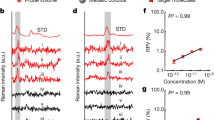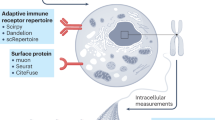Abstract
It is challenging to detect a broad range of malignant tumours at high resolution, because of profound genetic and histological differences in cancerous tissue. Here, we report the design and performance of a fluorescent nanoprobe with transistor-like responses (transition pH = 6.9) for the detection of deregulated pH, which drives many of the invasive properties of cancer. The nanoprobe amplifies the fluorescence signal in the tumour over that in the surrounding normal tissues, resulting in a discretized, binary output signal with a spatial resolution smaller than 1 mm. The nanoprobe allowed us to image a broad range of tumours in mouse models using a variety of clinical cameras. We were able to perform real-time tumour-acidosis-guided detection and surgery of occult nodules (<1 mm3) in mice bearing head and neck or breast tumours, significantly lengthening mice survivability. We also show that the pH nanoprobe can be used as a reporter in a fast, quantitative assay to screen for tumour-acidosis inhibitors. The binary delineation of pH achieved by the nanoprobe promises to improve the accuracy of cancer detection, surveillance and therapy.
This is a preview of subscription content, access via your institution
Access options
Subscribe to this journal
Receive 12 digital issues and online access to articles
$99.00 per year
only $8.25 per issue
Buy this article
- Purchase on Springer Link
- Instant access to full article PDF
Prices may be subject to local taxes which are calculated during checkout






Similar content being viewed by others
References
Vogelstein, B. et al. Cancer genome landscapes. Science 339, 1546–1558 (2013).
van Dam, G. M. et al. Intraoperative tumor-specific fluorescence imaging in ovarian cancer by folate receptor-alpha targeting: first in-human results. Nat. Med. 17, 1315–1319 (2011).
Veiseh, M. et al. Tumor paint: a chlorotoxin:Cy5.5 bioconjugate for intraoperative visualization of cancer foci. Cancer Res. 67, 6882–6888 (2007).
Ke, S. et al. Near-infrared optical imaging of epidermal growth factor receptor in breast cancer xenografts. Cancer Res. 63, 7870–7875 (2003).
Koyama, Y. et al. Spectral fluorescence molecular imaging of lung metastases targeting HER2/neu. Clin. Cancer Res. 13, 2936–2945 (2007).
Nakajima, T. et al. Targeted, activatable, in vivo fluorescence imaging of prostate-specific membrane antigen (PSMA) positive tumors using the quenched humanized J591 antibody-indocyanine green (ICG) conjugate. Bioconjug. Chem. 22, 1700–1705 (2011).
Jacobs, T. W., Gown, A. M., Yaziji, H., Barnes, M. J. & Schnitt, S. J. HER-2/neu protein expression in breast cancer evaluated by immunohistochemistry. A study of interlaboratory agreement. Am. J. Clin. Pathol. 113, 251–258 (2000).
Paik, S. et al. HER2 and choice of adjuvant chemotherapy for invasive breast cancer: national surgical adjuvant breast and bowel project protocol B-15. J. Natl Cancer Inst. 92, 1991–1998 (2000).
Hanahan, D. & Weinberg, R. A. Hallmarks of cancer: the next generation. Cell 144, 646–674 (2011).
Heiden, M. G. V., Cantley, L. C. & Thompson, C. B. Understanding the Warburg effect: the metabolic requirements of cell proliferation. Science 324, 1029–1033 (2009).
Zhu, A., Lee, D. & Shim, H. Metabolic positron emission tomography imaging in cancer detection and therapy response. Semin. Oncol. 38, 55–69 (2011).
Webb, B. A., Chimenti, M., Jacobson, M. P. & Barber, D. L. Dysregulated pH: a perfect storm for cancer progression. Nat. Rev. Cancer 11, 671–677 (2011).
Gillies, R. J., Raghunand, N., Garcia-Martin, M. L. & Gatenby, R. A. pH imaging. A review of pH measurement methods and applications in cancers. IEEE Eng. Med. Biol. 23, 57–64 (2004).
Volk, T., Jahde, E., Fortmeyer, H. P., Glusenkamp, K. H. & Rajewsky, M. F. pH in human tumour xenografts: effect of intravenous administration of glucose. Br. J. Cancer 68, 492–500 (1993).
Wang, Y. et al. A nanoparticle-based strategy for the imaging of a broad range of tumours by nonlinear amplification of microenvironment signals. Nat. Mater. 13, 204–212 (2014).
Zhou, K. et al. Multicolored pH-tunable and activatable fluorescence nanoplatform responsive to physiologic pH stimuli. J. Am. Chem. Soc. 134, 7803–7811 (2012).
Li, Y. et al. Molecular basis of cooperativity in pH-triggered supramolecular self-assembly. Nat. Commun. 7, 13214 (2016).
Bardeen, J. Research leading to point-contact transistor. Science 126, 105–113 (1957).
Cook, G. J., Wegner, E. A. & Fogelman, I. Pitfalls and artifacts in 18FDG PET and PET/CT oncologic imaging. Semin. Nucl. Med. 34, 122–133 (2004).
Fukui, M. B. et al. Combined PET–CT in the head and neck: part 2. Diagnostic uses and pitfalls of oncologic imaging. Radiographics 25, 913–930 (2005).
Neri, D. & Supuran, C. T. Interfering with pH regulation in tumours as a therapeutic strategy. Nat. Rev. Drug Discov. 10, 767–777 (2011).
Sonveaux, P. et al. Targeting lactate-fueled respiration selectively kills hypoxic tumor cells in mice. J. Clin. Invest. 118, 3930–3942 (2008).
Cardone, R. A., Casavola, V. & Reshkin, S. J. The role of disturbed pH dynamics and the Na+/H+ exchanger in metastasis. Nat. Rev. Cancer 5, 786–795 (2005).
Vishvakarma, N. K. & Singh, S. M. Mechanisms of tumor growth retardation by modulation of pH regulation in the tumor-microenvironment of a murine T cell lymphoma. Biomed. Pharmacother. 65, 27–39 (2011).
Lou, Y. et al. Targeting tumor hypoxia: suppression of breast tumor growth and metastasis by novel carbonic anhydrase IX inhibitors. Cancer Res. 71, 3364–3376 (2011).
Pacchiano, F. et al. Ureido-substituted benzenesulfonamides potently inhibit carbonic anhydrase IX and show antimetastatic activity in a model of breast cancer metastasis. J. Med. Chem. 54, 1896–1902 (2011).
Gillies, R. J., Raghunand, N., Karczmar, G. S. & Bhujwalla, Z. M. MRI of the tumor microenvironment. J. Magn. Reson. 16, 430–450 (2002).
Gallagher, F. A. et al. Magnetic resonance imaging of pH in vivo using hyperpolarized 13C-labelled bicarbonate. Nature 453, 940–943 (2008).
Parks, S. K., Chiche, J. & Pouyssegur, J. Disrupting proton dynamics and energy metabolism for cancer therapy. Nat. Rev. Cancer 13, 611–623 (2013).
Ang, K. K. et al. Impact of epidermal growth factor receptor expression on survival and pattern of relapse in patients with advanced head and neck carcinoma. Cancer Res. 62, 7350–7356 (2002).
Maeda, H., Wu, J., Sawa, T., Matsumura, Y. & Hori, K. Tumor vascular permeability and the EPR effect in macromolecular therapeutics: a review. J. Control. Release 65, 271–284 (2000).
Commisso, C. et al. Macropinocytosis of protein is an amino acid supply route in Ras-transformed cells. Nature 497, 633–637 (2013).
More, Y. I. et al. Functional swallowing outcomes following transoral robotic surgery vs primary chemoradiotherapy in patients with advanced-stage oropharynx and supraglottis cancers. JAMA Otolaryngol. Head Neck Surg. 139, 43–48 (2013).
Anscher, M. S. et al. Local failure and margin status in early-stage breast carcinoma treated with conservation surgery and radiation therapy. Ann. Surg. 218, 22–28 (1993).
Schmidt-Ullrich, R. et al. Tumor margin assessment as a guide to optimal conservation surgery and irradiation in early stage breast carcinoma. Int. J. Radiat. Oncol. 17, 733–738 (1989).
Solin, L. J., Fowble, B. L., Schultz, D. J. & Goodman, R. L. The significance of the pathology margins of the tumor excision on the outcome of patients treated with definitive irradiation for early stage breast cancer. Int. J. Radiat. Oncol. 21, 279–287 (1991).
Holland, R. et al. The presence of an extensive intraductal component following a limited excision correlates with prominent residual disease in the remainder of the breast. J. Clin. Oncol. 8, 113–118 (1990).
Zhou, K. et al. Tunable, ultrasensitive pH-responsive nanoparticles targeting specific endocytic organelles in living cells. Angew. Chem. Int. Ed. 50, 6109–6114 (2011).
Matyjaszewski, K. & Tsarevsky, N. V. Nanostructured functional materials prepared by atom transfer radical polymerization. Nat. Chem. 1, 276–288 (2009).
Ma, X. et al. Ultra-pH-sensitive nanoprobe library with broad pH tunability and fluorescence emissions. J. Am. Chem. Soc. 136, 11085–11092 (2014).
Acknowledgements
This work was supported by the National Institutes of Health (R01EB013149 and R01CA192221, to J.G.) and Cancer Prevention and Research Institute of Texas (RP140140, to B.D.S. and J.G.). Animal imaging work was supported by the UT Southwestern Small Animal Imaging Resource Grant (U24 CA126608) and Simmons Cancer Center Support Grant (P30 CA142543). We thank J. Sun for animal imaging, L.C. Su for histology analysis, D. Zhao for preparation of the U87 brain tumour model, A. Pavia-Jimenez and J. Brugarolas for the renal PDX model and G. Balch for the peritoneal metastatis model.
Author information
Authors and Affiliations
Contributions
T.Z., B.D.S and J.G. are responsible for all phases of the research. G.H., S.Y., M.L. and Z.Z. assisted animal surgery, tumour-margin analysis and safety evaluation. Y.L. helped develop the transistor concept and performed TEM analysis. S.R. and X.K.S. designed the FDG–PET experiment and performed image analysis. Z.Q.L. performed the imaging comparison of PINS with other commercial probes. Y.G.W. and E.B. helped with fluorescence imaging and X.P.M. assisted with the design and synthesis of the PEPA polymer. B.D.S. and T.Z. performed the survival surgery in mice bearing head and neck cancer, and breast cancer, respectively. X.J.X. performed the statistical analysis. J.T. interpreted the histology slides. R.A.B. helped establish genetic pancreatic models and histology interpretations.
Corresponding authors
Ethics declarations
Competing interests
B.D.S. and J.G. are scientific co-founders of OncoNano Medicine, Inc.
Supplementary information
Supplementary Information
Supplementary methods, figures and tables, and video captions. (PDF 3212 kb)
Video 1
Real-time tumour acidosis guided surgery (TAGS) of a HN5 head/neck tumour-bearing mouse using the SPY Elite camera. (MOV 16223 kb)
Video 2
Real-time TAGS of an orthotopic 4T1 breast tumour-bearing mouse using the SPY Elite. (MOV 9731 kb)
Video 3
Real-time TAGS of a small occult breast tumour-bearing mouse using the SPY Elite camera. (MOV 10775 kb)
Rights and permissions
About this article
Cite this article
Zhao, T., Huang, G., Li, Y. et al. A transistor-like pH nanoprobe for tumour detection and image-guided surgery. Nat Biomed Eng 1, 0006 (2017). https://doi.org/10.1038/s41551-016-0006
Received:
Accepted:
Published:
DOI: https://doi.org/10.1038/s41551-016-0006
This article is cited by
-
Severely polarized extracellular acidity around tumour cells
Nature Biomedical Engineering (2024)
-
High-precision detection and navigation surgery of colorectal cancer micrometastases
Journal of Nanobiotechnology (2023)
-
Image-guided cancer surgery: a narrative review on imaging modalities and emerging nanotechnology strategies
Journal of Nanobiotechnology (2023)
-
How protons pave the way to aggressive cancers
Nature Reviews Cancer (2023)
-
Micro-engineering and nano-engineering approaches to investigate tumour ecosystems
Nature Reviews Cancer (2023)



